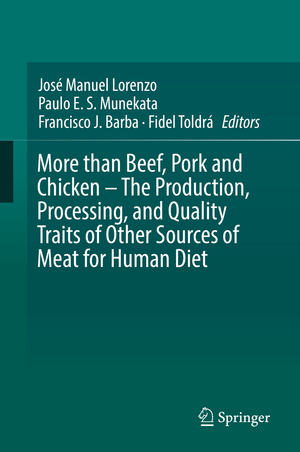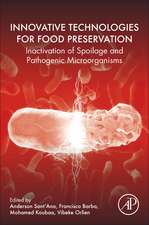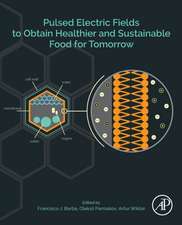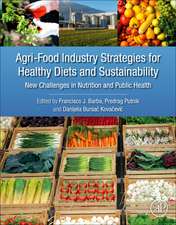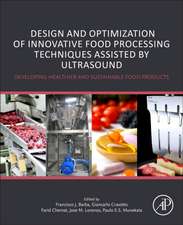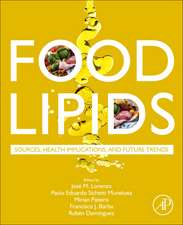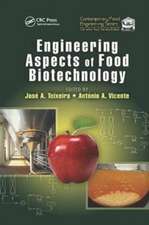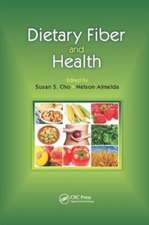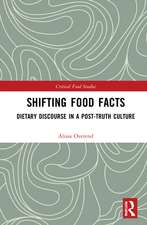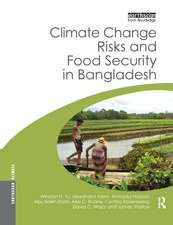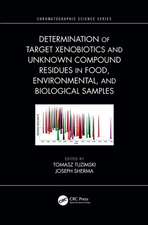More than Beef, Pork and Chicken – The Production, Processing, and Quality Traits of Other Sources of Meat for Human Diet
Editat de José Manuel Lorenzo, Paulo E. S. Munekata, Francisco J. Barba, Fidel Toldráen Limba Engleză Hardback – 18 feb 2019
More than Beef, Pork and Chicken – The Production, Processing, and Quality Traits of Other Sources of Meat for Human Diet also focuses on the important role meat plays in the human diet and the evolution of the species. Beneficial factors such as protein, B complex vitamins, zinc, selenium and phosphorus are detailed. Negative factors are discussed as well, with issues such as fat and fatty acid content being addressed for each type of meat presented. In exploring the full range of nutritional benefits, consumer acceptance and carcass characteristics in a large quantity of different types of animal meats from all over the world, this book offers incredible value to researchers looking for a single source on unconventional meat processing.
Preț: 653.33 lei
Preț vechi: 768.62 lei
-15% Nou
Puncte Express: 980
Preț estimativ în valută:
125.03€ • 130.05$ • 103.22£
125.03€ • 130.05$ • 103.22£
Carte tipărită la comandă
Livrare economică 14-28 aprilie
Preluare comenzi: 021 569.72.76
Specificații
ISBN-13: 9783030054830
ISBN-10: 3030054837
Pagini: 463
Ilustrații: XIV, 416 p. 53 illus., 41 illus. in color.
Dimensiuni: 155 x 235 x 27 mm
Greutate: 0.78 kg
Ediția:1st ed. 2019
Editura: Springer International Publishing
Colecția Springer
Locul publicării:Cham, Switzerland
ISBN-10: 3030054837
Pagini: 463
Ilustrații: XIV, 416 p. 53 illus., 41 illus. in color.
Dimensiuni: 155 x 235 x 27 mm
Greutate: 0.78 kg
Ediția:1st ed. 2019
Editura: Springer International Publishing
Colecția Springer
Locul publicării:Cham, Switzerland
Cuprins
1. Meat in the human diet: a biosocial perspective.- 2. Meat quality, brands and consumer trends.- 3. Horsemeat: increasing quality and nutritional value.- 4. Camel carcass and meat quality characteristics .- 5. Carcass characteristics and meat quality of bison, buffalo, and yak.- 6. Carcass characteristics and meat quality of sheep and goat.- 7. Carcass traits and meat quality of rabbit, hare, guinea pig and capybara.- 8. Wild boar - Production, meat quality traits and derived products.- 9. Carcass characteristics and meat quality of deer.- 10. Carcass characteristics, meat quality and nutritional profile of pheasant, quail and Guinea fowl.- 11. Goose, Duck and Garganey.- 12. Meat production from wild kangaroo: the species, industry, carcass characteristics and meat quality traits.- 13. Exotic meats: An alternative food source.
Notă biografică
Jose Lorenzo is a Head of Research at the Meat Technological Center in Ourense, Spain. He is also Associate Professor of Food Technology at the University of Vigo.
Paulo Munekata is a researcher at the Meat Technological Center in Ourense, Spain
Francisco Barba is a Professor in the Faculty of Pharmacy at the University of València in València, Spain
Fidel Toldrá is a Research Professor and Head of the Laboratory of Biochemistry, Innovation and Technology of Meat and Meat Products at the Instituto de Agroquímica y Tecnología de Alimentos (CSIC). He is also Associate Professor of Food Technology at the Polytechnical University of Valencia.
Textul de pe ultima copertă
This comprehensive work explores the demand, supply and variable consumer attitude toward a wide variety of unconventional and exotic animal species that are consumed in different parts of the world. Individual chapters focus on the consumption of horse meat, camel, buffalo, sheep, rabbit, wild boar, deer, goose, pheasant and exotic meats such as alligator, snake, frog and turtle. For each type of animal species, the carcass characteristics, physico-chemical properties and nutritional value of the meat are extensively outlined. The consumer preference, behavior and perception of each type of meat are also covered, with focus on important factors from sensory properties to psychological and marketing aspects. In promoting a better understanding of the complexities involved in consumer decision making, this book aims to improve the competitiveness of the meat industry through effective informational strategies that can increase consumer acceptance of more convenient, healthy and environmentally friendly meat choices.
More than Beef, Pork and Chicken – The Production, Processing, and Quality Traits of Other Sources of Meat for Human Diet also focuses on the important role meat plays in the human diet and the evolution of the species. Beneficial factors such as protein, B complex vitamins, zinc, selenium and phosphorus are detailed. Negative factors are discussed as well, with issues such as fat and fatty acid content being addressed for each type of meat presented. In exploring the full range of nutritional benefits, consumer acceptance and carcass characteristics in a large quantity of different types of animal meats from all over the world, this book offers incredible value to researchers looking for a single source on unconventional meat processing.
More than Beef, Pork and Chicken – The Production, Processing, and Quality Traits of Other Sources of Meat for Human Diet also focuses on the important role meat plays in the human diet and the evolution of the species. Beneficial factors such as protein, B complex vitamins, zinc, selenium and phosphorus are detailed. Negative factors are discussed as well, with issues such as fat and fatty acid content being addressed for each type of meat presented. In exploring the full range of nutritional benefits, consumer acceptance and carcass characteristics in a large quantity of different types of animal meats from all over the world, this book offers incredible value to researchers looking for a single source on unconventional meat processing.
Caracteristici
Comprehensively covers the demand, supply and variable consumer attitude toward a wide variety of unconventional and exotic animal species that are consumed in different parts of the world Focuses on the production, processing and quality traits of a wide range of unconventional and exotic meats such as horse meat, camel, buffalo, sheep, rabbit, wild boar, deer, goose, pheasant and exotic meats such as alligator, snake, frog and turtle Covers consumer preference, behavior and perception involved with different types of unconventional and exotic meats, with focus on important factors from sensory properties to psychological and marketing aspects
